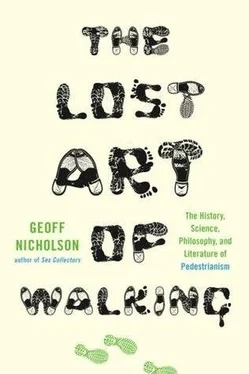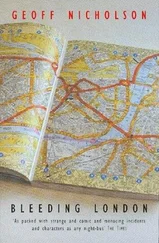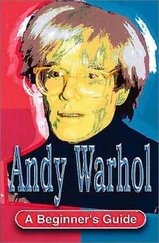Sometimes, especially in the winter, there’s water on the flat, low desert bed standing perfectly, eerily still, reflecting the mountains and the sky like a mirror. From a distance you can’t possibly guess how deep the water is — it’s easy to imagine it profound and limitless — but in fact large stretches are no more than a couple of inches deep.
In these conditions hundreds of people walk out from the parking lot, drawn into the emptiness, like true believers, like earthlings going out to meet the mother ship. But since there is no mother ship, nothing to believe in, they just go and investigate the water, discover how shallow and smooth it is, then walk a few yards into it and have their friends and family take pictures of them so they look as though they’re walking on water.
Abul Hasan al-Shadhili, a thirteenth-century Sufi master, warned would-be mystics to avoid performing miracles such as walking on water. He regarded it as a distraction and a form of showing off. Of course there is some anti-Christian sentiment at play here, but also the idea that walking on water is a perfectly achievable goal.
And so, at Badwater, hundreds of people appear to go walking on water. It’s playful, good-natured, and as far as I can see, not remotely sacrilegious. Even so, you have to think that it wouldn’t mean nearly as much if we weren’t all familiar with Jesus’ biblical example. I found it impossible to avoid singing Leonard Cohen’s line from his song ‘Suzanne’: ‘Jesus was a sailor when he walked upon the water’. But obviously this is nonsense. If there was ever a moment when Jesus wasn’t a sailor it was precisely when he walked on the Sea of Galilee — when he was absolutely a pedestrian.
I also found myself thinking about a line from Jack Kerouac, a born Catholic turned self-invented Buddhist, and a man who did his share of walking in nature. He had serious doubts about LSD, chiefly because it seemed to offer an instant religious experience. He thought this was a cheat. He thought religious enlightenment was something you had to work for, that couldn’t be found at the drop of a hat. He summed it up perfectly for me when he said, ‘Walking on water wasn’t built in a day’.
8. the Walking Photograph
Consulting the rules of composition before taking a photograph is like consulting the laws of gravity before going for a walk.
— EDWARD WESTON
Garry Winogrand, walking on the crowded streets of New York in the 1970 s, carrying a Leica M4 with a 28mm lens, the leather strap wound tightly round his hand, the camera being constantly raised and lowered to and from his eye, turning his head, refocusing his gaze, looking for visual triggers, for subjects, endlessly, relentlessly pressing the shutter, shooting pictures, sometimes just shooting.
Winogrand walks, but not at the same pace as the pedestrians around him, and sometimes he stops completely so that the flow of people splits and eddies past, and sometimes he sees something on the other side of the street, and pushes through the crowd, dashes over there, dodging traffic or forcing the traffic to dodge him. Then he continues taking photographs. You’d think that New York’s angry, purposeful walkers would knock him out of the way, walk all over him; but he’s found a way to avoid that.
Sometimes he smiles and nods at the people he’s photographing, offers a word or two, chats, and in the main nobody minds. It’s a technique he’s developed, a way of presenting himself as just another eccentric on the streets of New York, crazy, self-absorbed, obsessive but essentially harmless — which is not a complete misrepresentation of Winogrand.
And then somebody perceives him as something else. A woman, irate, offended, full of righteous indignation, believes that in photographing her, Winogrand has stolen something from her. ‘Hey, you took my picture!’ she protests, and Winogrand, in his rough, tough, amused New York voice, says, ‘Honey, it’s my picture now’. It’s an old story, and another one that I very much want to be true.
♦
Garry Winogrand (1928–1984) was from the Bronx. He told Tod Papageorge that when he was about ten years old he walked the streets of his neighborhood until midnight to avoid going home to the family apartment, because ‘his parents did not put a high priority on privacy’. The idea that the streets offer more privacy than the family home is one that needs no explaining.
Winogrand was a street photographer, by most reckonings the ultimate street photographer. The term is a porous one: even the most studio-bound of photographers occasionally takes a photograph on the street. And paparazzi are certainly street photographers of a sort, along with their modern mutations, the stalkerazzi and the snapperazzi — members of the public who happen to see a celeb in the street and take their picture.
You might also think it’s a term that doesn’t require much definition: if you take a photograph in the street you’re a street photographer. Well, not quite. Eddie Adams was certainly in the street in Saigon in 1968 when he photographed the Vietnamese chief of police, Nguyen Ngoc Loan, walking up to a suspected Vietcong collaborator and shooting him in the head, but he wasn’t quite a street photographer in the way that Winogrand was.
A street photographer, as we generally conceive it, is someone who finds subject matter not in exotic locales or war zones, but in quotidian settings, in public, in the city. If, in the process, he or she manages to make that setting look like an exotic locale or a war zone, then so much the better. There was a time when these photographs were often referred to as ‘candids’, but nobody seems to use that word anymore. Perhaps candidness is no longer considered something that a photograph can offer us.
All my favorite photographers are, in some sense or another, at least some of the time, street photographers: Henri Cartier-Bresson, Robert Frank, William Klein, Diane Arbus, Stephen Shore, William Eggleston, Martin Parr, Bruce Gilden, as well as Winogrand. Some of these people view the world with a comparatively benign eye — others are downright brutal in their gaze. In either case the streets offer them the kind of subjects they’re looking for, that they and their art need.
There are ways in which street photography might seem very straightforward. There’s no need for props, lights, assistants, paid models, stylists, or any of the other detritus that some photographers carry with them. You simply go out with your camera and take pictures of what’s there. There may be some premeditation, but in the end it’s an improvised form with an unpredictable outcome, a sort of visual free jazz.
And yet a moment’s thought tells you that there’s nothing straightforward about it at all. Much of street life is actually quite banal. Even in a city as full of grotesques as New York, for every character there are thousands of ordinary Joes. People come and go rapidly, without arranging themselves into attractive or dramatic tableaux.
Conflict and awkwardness may be part of the deal — nevertheless, the best street photographers do demonstrate something that looks like ease. They’re at home in their environment, they’re able to operate confidently in public, among people. Street photographers share a space with their subjects, are on equal footing, in the same place at the same time.
What makes a great street photographer is the amount of walking he or she does. Street photographers inevitably take a lot of photographs of people walking. Just as inevitably they themselves spend a lot of time walking as they look for subjects. They are walkers who photograph other walkers.
Luck plays an enormous part in street photography, and the cliché remains true that the more work you put in, the luckier you get. There are times when Winogrand seems to have had the luck of the devil. Every time he walked down the street, dwarves, identical twins, and people cuddling monkeys would appear and pose themselves for his delight.
Читать дальше












